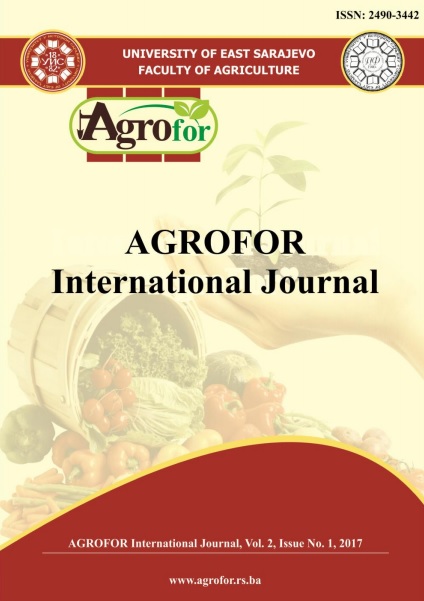LEVEL OF LARVAL ATACK ON MAIZE ROOTS AS A CONSEQUENCE OF ARTIFICIAL INFESTATION WITH WESTERN CORN ROOTWORM EGGS
DOI:
https://doi.org/10.7251/AGRENG1701132TAbstract
The Western corn rootworm (WCR), Diabrotica virgifera sp. virgifera
(Col.,Chrysomelidae), is an oligophagous pest native in America. WCR is a maize
pest present in all regions of the Corn Belt. It is an invasive species which was, in
Europe, first identified in Serbia, in 1992, near the Belgrade airport. The presence
of this pest in maize field can cause losses and plant damages up to 100%. A field
experiment was carried out in Bečej, Vojvodina province (Serbia), during 2014 and
2015. In the field, 96 plants (maize cultivar NS 640), arranged in 48 pairs were
selected. Each pair consisted of one plant artificially infested with WCR eggs (D
plant) and the control plant (C plant). In both years, the experiment in the field was
regularly inspected, once a week. During each observation, the presence of "goose
neck" symptoms was recorded, and the number of plants damaged by the most
important stem boring and leaf feeding insects (Ostrinia nubilalis, Helicoverpa
armigera, H. zeae, aphids, mites, cicadas, etc. ) was counted. Root damages were
assessed at the end of the experiment (September), according to Ostlie and Notzel
(1987), on scale 1-6. Comparing the root damages on C and D plants, less root
damages were established on C plants. Only six i. e. four D plants had healthy roots
(rate 1) during 2014 and 2015, respectively. Between D plants in 2014, the most
damaged were14 plants, with the rate 3 (least one root chewed to within 1½ inches
(3. 8 cm) of the plant). In 2015, severe damages were registered on 18 plants,
which were ranked as level 6 (with three or more nodes destroyed). Only two C
plants during vegetation 2014-2015were registered with damages with rate 5 (two
nodes destroyed) and rate 6 (three or more nodes destroyed), respectively.

